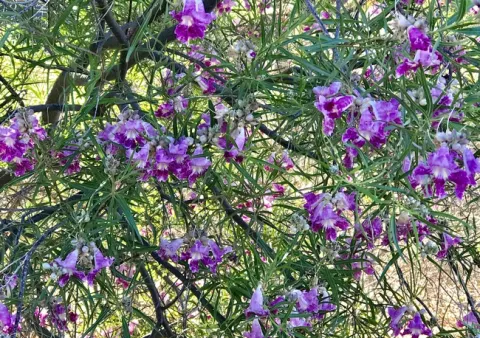
Plants We Love
By Jackie Woods UCCE Master Gardener
Common name: Desert Willow, Desert Catalpa
Latin name: Chilopsis linearis
Size of plant: Height 15-40 feet; width 10-20 feet
Bloom description and season: Showy, fragrant pink or white flowers bloom in spring through summer.
Exposure: Full sun to partial shade.
Water needs: Low water requirements, drought tolerant.
USDA Hardiness: Zones 8-9.
Sunset Zone: 7 – 14 and 18-23.
Description: Desert willow is a stunning, versatile shrub (or tree.) It is a deciduous member of the trumpet vine family (Bignoniaceae), native to the southwest. It is not a willow but gets the name due to its wispy, linear willow-like leaves. Desert willow produces trumpet-shaped, flowers ranging in color from white, light pink to light purple. These flowers attract hummingbirds, native bees (bumblebees) and several bird species who feast on the seeds of the desert willow. A fast grower with a twisting trunk, spreading crown and low branches, desert willow does well in arid climates, tolerates extreme drought yet will also tolerate seasonal flooding. This shrub thrives in well-drained soil but will also grow well in sand, loam and clay-type soils. Its water requirements are low, Desert willow will enjoy a watering or two during extreme hot weather but prolong saturation can result in rot so avoid excessive watering. Avoid fertilizing which can cause rapid growth, fewer blooms and a weak plant. Desert willow is basically disease and pest-free and it seeds itself into the landscape so don't plant this one in or near a lawn. Do, however, plant it as erosion control, a windbreak or for wildlife cover. Prune when dormant to desired look -tree-like versus shrub shaped. In the fall, flowers will be replaced with long seed pods and seeds can be extracted from the pods by drying them and shaking the seeds from the pods. Desert willow can be propagated via seed, dormant hardwood cuttings or mid-summer softwood cuttings. Seeds will sprout in 1 to 3 weeks under moist, warm conditions but allow the soil to somewhat dry out in between watering.

